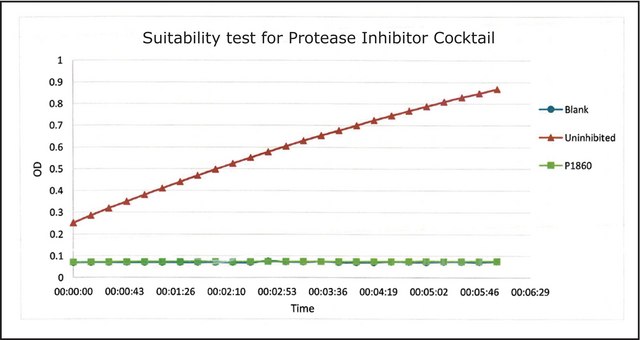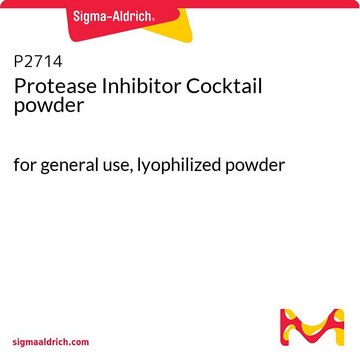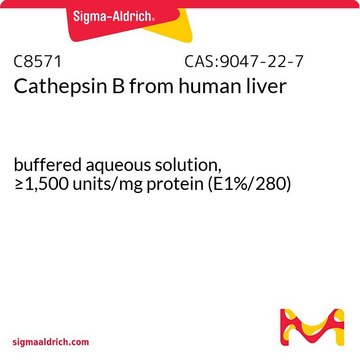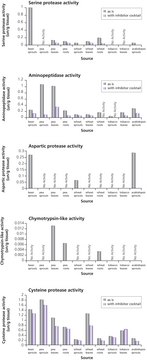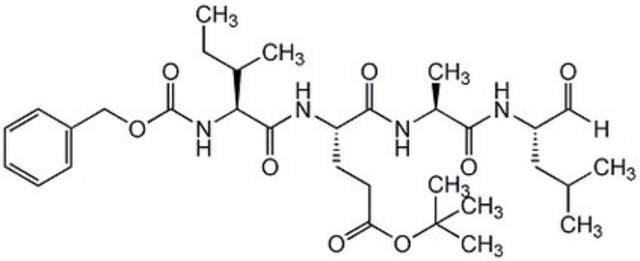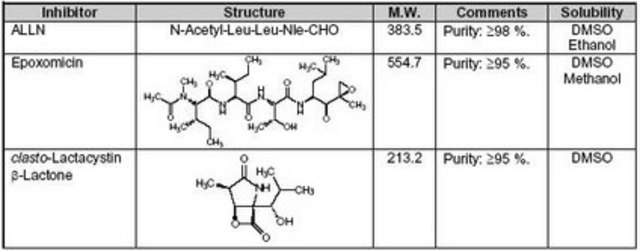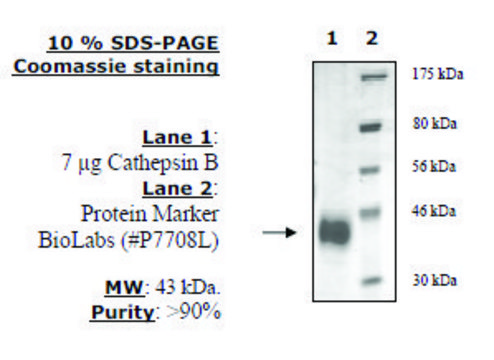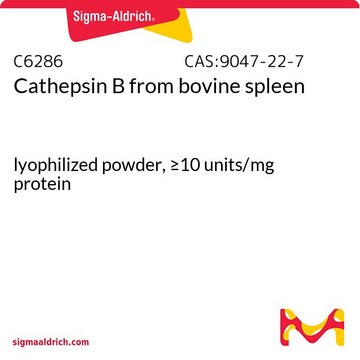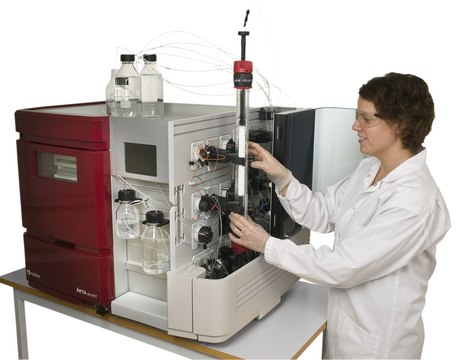539175
Proteasome Inhibitor IV
The Proteasome Inhibitor IV controls the biological activity of Proteasome. This small molecule/inhibitor is primarily used for Protease Inhibitors applications.
别名:
Proteasome Inhibitor IV, Z-GPFL-CHO
登录查看公司和协议定价
所有图片(1)
About This Item
经验公式(希尔记法):
C30H38N4O6
分子量:
550.65
UNSPSC代码:
12352200
推荐产品
质量水平
方案
≥90% (HPLC)
表单
lyophilized solid
制造商/商品名称
Calbiochem®
储存条件
OK to freeze
protect from light
颜色
white
溶解性
DMSO: 5 mg/mL
运输
ambient
储存温度
−20°C
一般描述
A tetrapeptide aldehyde that acts as a highly selective and potent proteasomal inhibitor (Ki = 1.5 µM for branched chain amino acid preferring, 2.3 µM for small neutral amino acid preferring, and 40.5 µM for chymotrypsin-like activities; IC50 = 3.1 µM for peptidyl-glutamyl peptide hydrolyzing activity). Shown to be a weak inhibitor of trypsin-like proteasomal activity.
生化/生理作用
Cell permeable: no
Primary Target
branched chain amino acid preferring,small neutral amino acid preferring, chymotrypsin-like activities
branched chain amino acid preferring,small neutral amino acid preferring, chymotrypsin-like activities
Product does not compete with ATP.
Reversible: no
Target Ki: 1.5 µM, 2.3 µM, and 40.5 µM against branched chain amino acid preferring, small neutral amino acid preferring, and chymotrypsin-like activities of proteasomes, respectively
包装
Packaged under inert gas
警告
Toxicity: Standard Handling (A)
序列
Z-Gly-Pro-Phe-Leu-CHO
重悬
Following reconstitution aliquot and freeze (-20°C). Stock solutions are stable for up to 6 months at -20°C.
其他说明
Oberdorf, J., et al. 2001. Biochemistry40, 13397.
Cardozo, C., et al. 1999. Biochemistry38, 9768.
Eleuteri, A.M., et al. 1997. J. Biol. Chem.272, 11824.
Orlowski, M., et al. 1997. Biochemistry36, 13946.
Vinitsky, A., et al. 1994. J. Biol. Chem.269, 29860.
Cardozo, C., et al. 1999. Biochemistry38, 9768.
Eleuteri, A.M., et al. 1997. J. Biol. Chem.272, 11824.
Orlowski, M., et al. 1997. Biochemistry36, 13946.
Vinitsky, A., et al. 1994. J. Biol. Chem.269, 29860.
法律信息
CALBIOCHEM is a registered trademark of Merck KGaA, Darmstadt, Germany
储存分类代码
11 - Combustible Solids
WGK
WGK 1
闪点(°F)
Not applicable
闪点(°C)
Not applicable
J Oberdorf et al.
Biochemistry, 40(44), 13397-13405 (2001-10-31)
Misfolded proteins in the endoplasmic reticulum (ER) are degraded by N-terminal threonine proteases within the 26S proteasome. Each protease is formed by an activated beta subunit, beta5/X, beta1/Y, or beta2/Z, that exhibits chymotrypsin-like, peptidylglutamyl-peptide hydrolyzing, or trypsin-like activity, respectively. Little
A M Eleuteri et al.
The Journal of biological chemistry, 272(18), 11824-11831 (1997-05-02)
Amino acid sequencing of subunits of the multicatalytic proteinase complex (MPC) isolated from bovine spleen showed an almost complete replacement of the X, Y, and Z subunits, constitutively expressed in most tissues, by the interferon-gamma-inducible LMP7, LMP2, and MECL1 subunits.
A Vinitsky et al.
The Journal of biological chemistry, 269(47), 29860-29866 (1994-11-25)
Evidence indicates that a component of the multicatalytic proteinase complex (MPC) that preferentially cleaves bonds after branched chain amino acids (BrAAP) is a major factor responsible for the protein-degrading activity of the MPC. We report here the synthesis of substrate-related
C Cardozo et al.
Biochemistry, 38(30), 9768-9777 (1999-07-28)
Two catalytic components of the multicatalytic proteinase complex (MPC, proteasome) designated as chymotrypsin-like (ChT-L) and branched chain amino acid preferring (BrAAP) cleave bonds after hydrophobic amino acids. The possible involvement of the ChT-L and peptidylglutamyl-peptide hydrolyzing (PGPH) activities in the
M Orlowski et al.
Biochemistry, 36(45), 13946-13953 (1997-12-31)
Exposure to [14C]-3,4-dichloroisocoumarin (DCI) of multicatalytic proteinase complexes (MPC) isolated from bovine pituitary and spleen leads to label incorporation into several beta-type subunits, to rapid inactivation of the chymotrypsin-like (ChT-L) activity, and to a slower inactivation of other activities of
我们的科学家团队拥有各种研究领域经验,包括生命科学、材料科学、化学合成、色谱、分析及许多其他领域.
联系技术服务部门